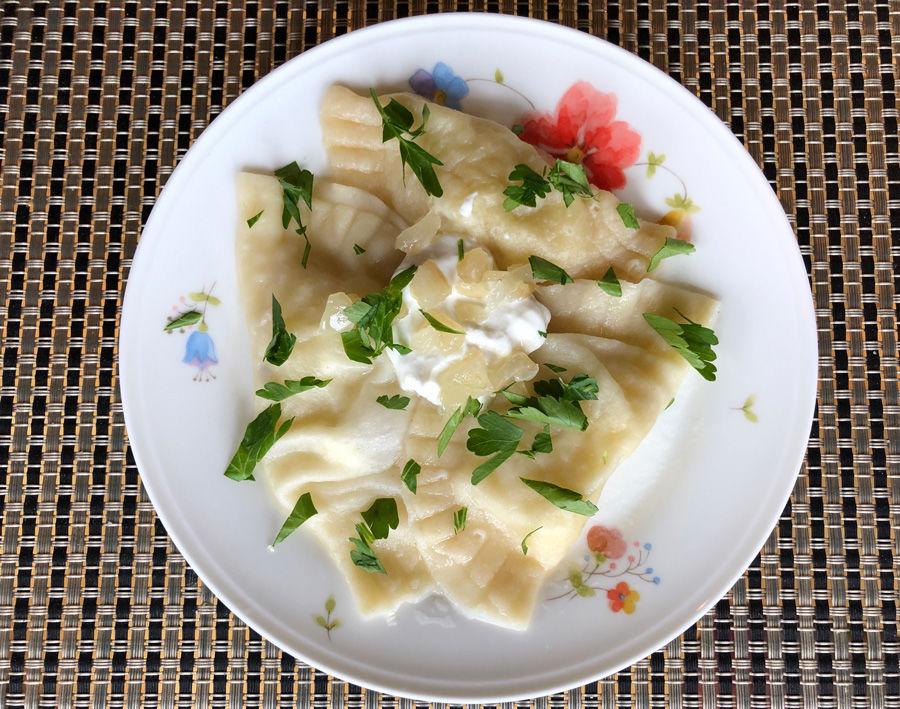Secret is out on special Purim dumplings
Published February 22, 2018
The holiday of Purim is rife with secrets. Queen Esther hid her religious beliefs from King Achashveros. Her Uncle Mordechai discovered a secret plot to kill the King. And King Achashveros did not know that Mordechai, the man who refused to bow down to Haman, was Esther’s uncle.
In celebration of Purim, we dress up in costumes that conceal our identities, another reference to secrets, and we are encouraged to drink alcoholic beverages that embolden us to let go of our deepest secrets. And, of course, as is customary, we enjoy a Purim feast that concludes with Hamentaschen, a cookie in the shape of Haman’s hat (or perhaps his ears) in which only a portion of the filling is revealed.
There are many clever ways to create a Purim feast that is in keeping with the “secret” theme. In addition to hamentaschen, Purim fare could include kreplach, blintzes, burekas (see my recipe, http://bit.ly/JL-Bourekas), or a challah filled with dates (http://bit.ly/JL-Date-Challah), or onions.
I recently discovered a new “secret” Purim treat. They are called varenikes. I learned about them from Joy Stinger, a gifted weaver, painter, quilter, gardener, and bird lover. She may best be known in our community as the lovely Clayton beekeeper. Joy has been keeping bees for the past 30 years, and currently sells her honey to Straub’s, Winslow’s Home, University Gardens, Parker’s Table, Starr’s, and Schnarr’s Hardware. And, by the way, she won’t turn you away if you stop by her home to purchase a jar.
I met Joy many years ago at her honey stand at the Clayton Farmers Market. Fast forward to a month ago when both Joy and her friend, neighbor, and cooking buddy Andrea Rosenblum attended a knish class I was teaching at Crown Center. When I asked if anyone in the group would like to come up to help me form knishes, Joy, now 82 years old, bounced up and said, “Of course, I would love to!”
While we pinched knishes, Joy asked whether I had ever made varenikes.
“Never heard of them,” I replied.
Joy asked Andrea to email me her hand-written recipe for varenikes. I read over the recipe and scoured the internet for information. As I learned, varenikes are Ukranian dumplings filled with potatoes and onions. They were traditionally reserved for special holidays such as Yom Kippur, Hanukkah, and Purim. Though they resemble Ashkenazi kreplach in form, they are boiled and served more like piroshky, usually topped with sour cream.
So just last week when I began working on my Purim column, I knew I was going to make varenikes. I called Joy to ask her more about her fascination with this unique dumpling.
She told me that she first tasted varenikes about 40 years ago, when Sara Sherman, the mother of her partner, Alan Sherman, prepared them.
“I liked them a whole lot and hoped to one day be able to make them,” Joy told me. “I had cooked with Sara many times. We made gefilte fish and mohn cookies and a fish dish with a lot of lemon juice. However, we never made varenikes together, and I don’t remember her using recipes for anything.”
About two years ago, Alan gave Joy a cookbook called The Encyclopedia of Jewish Cooking by Gil Marks. She was thrilled when she came across a brief history of varenikes in the book. However, much to her dismay, there was no recipe.
Years later, when Joy and Andrea were cooking together one day Joy mentioned varenikes. Andrea was able to find a recipe that she shared with Joy.
“We haven’t made varenikes yet,” Joy told me, “but it’s on our to-do list.”
Well, that piqued my curiousity and I decided to try to create varenikes using the recipe that Joy had shared with me.
Making varenikes is similar to making other dumplings. You need to prepare the dough ahead of time so that the gluten can relax, which makes it easier to roll the dough thin. And just as with any dumpling, lightly dabbing the edges of the dough circles with an egg wash before closing them will ensure that the dumplings stay sealed while they cook.
And as with other dumplings, varenika fillings can vary. You could fill your varenikes with a ground meat filling or perhaps a spinach and feta combination, similar to that of a spanakopita. You could also make the varenikes sweet by filling them with a sweetened ricotta with lemon zest and snipped dried fruit.
I prepared the varenikes, tweaking Joy’s recipe a bit. They were delicious!
Chag samaech.
To learn more about Joy Stinger, visit this YouTube video: https://www.youtube.com/watch?v=taS-IfYDl8k.
Margi Lenga Kahn is the mother of five and grandmother of five. A cooking instructor at the Kitchen Conservatory, she is working on a project to preserve the stories and recipes of heritage cooks. She welcomes your comments and suggestions at [email protected].















